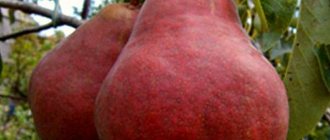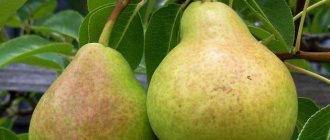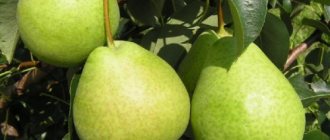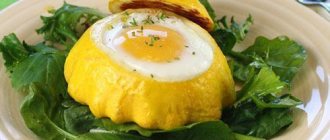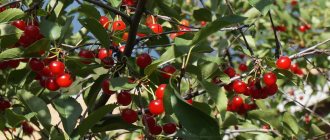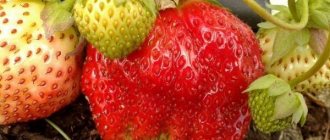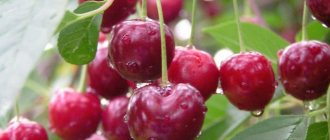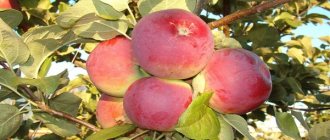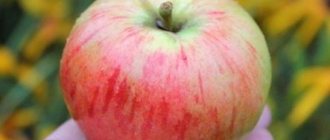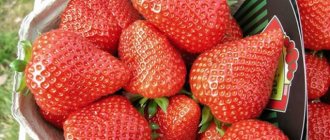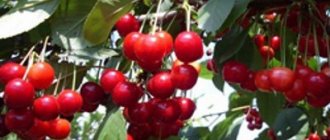Description of the variety
The early ripening pear from Michurinsk produces a harvest earlier than other varieties. This is due to winter-hardy genetic material. The plant is crossed with the Citron de Carm cultivar. One of the researchers of this type of pear plant is S.P. Yakovlev and A.P. Gribanovsky. It was they who bred the early ripening pear.
Agrotechnical work and basic recommendations
When growing crops on a personal plot or garden plot, it is recommended to adhere to some basic requirements of agricultural technology.
Deadlines
The time of planting seedlings is determined by the geographical location of the region where the crop grows:
- Southern - early - mid-autumn.
- Northern - in the spring after the snow melts.
- Middle lane - both options.
Related article:
How to deal with scab on apple and pear trees
For beginners in gardening, it is better to choose the spring planting method, as it is less risky.
Reproduction
The following growing options are available:
- From seeds. The method of reproduction is considered quite troublesome and time-consuming. It can take up to 2 years to reach the full-fledged seedling stage. There is also a risk of obtaining weak sprouts that are not suitable for further cultivation.
It is recommended to purchase seeds from trusted manufacturers.
- Saplings. Guaranteed propagation method, provided that high-quality material purchased from nurseries is used. The unpretentiousness of the variety and high survival rate make the pear accessible to cultivation even for beginners.
When choosing, you should give preference to a plant 1-2 years old, with a uniform shade of the trunk and branches without damage. You also need to carefully examine the root system. The main requirements are the absence of rot, growths, and branching.
- Grafting to other varieties. The method is suitable for gardeners with some experience and knowledge.
Read more: Budding pear to pear
Place
For planting, you need to choose an elevated place with good sunlight, because the sweetness and taste depend on its quantity. The minimum depth of groundwater is 2.5 m.
Related article:
How to pin pear to pear
Also, you should not choose a place in the shade of high fences, buildings and structures.
The soil
The crop does not have any special soil requirements, but for planting you need to choose fertile soils with good air permeability and the ability to pass water. Places with moisture retention are not suitable.
Landing
On a selected plot of land, dig a hole measuring at least 70*70*70 cm, the optimal parameters are 1*1*1 m. A drainage layer (up to 15 cm) is laid at the bottom; expanded clay, small crushed stone or broken brick can be used for it.
Place a wooden stake up to 150 cm high in the center to secure and tie up the young seedling.
Mix the soil from the pit with a bucket of compost and humus, and add a phosphorus-potassium preparation. Make a hill of soil, plant a seedling, distribute the roots. Fill the hole with the prepared substrate and compact it well. Pour 1 bucket of warm water into the area around the trunk. The root collar should protrude 3-5 cm above the soil surface.
Related article:
The best varieties of pears for the garden
Watering and care
To create a microclimate inside the soil and retain moisture, it is recommended to mulch with straw or mowed grass.
Watering is carried out as needed and when the soil dries out. When there is drought in the summer months, the tree must be watered frequently and abundantly. A lack of moisture will negatively affect the taste - astringency may appear.
Regular weeding, loosening (no deeper than 12 cm) and weed removal are also important.
At the end of the warm season, you need to collect mulch, fallen leaves and branches, and dig up the ground. This will minimize the risk of pest invasion in the spring after the snow melts.
Top dressing
Very young seedlings in the first years of life are usually not fed - they received nutrients during planting. Later, when the first flowers and ovaries form, fertilization is practiced according to the following scheme:
- In the spring, before and after the buds open, nitrogen-based fertilizers (urea, ammonium nitrate) are used.
- Before the arrival of cold weather, superphosphate is added to the soil in the near-stem zone.
Related article:
Proper planting of pears on the site
Tips for summer residents: Autumn application of fertilizer for the garden
Collection and storage
Pears are removed in the second half of July (20th). The shelf life for food when stored at room temperature is 3-7 days, at +4 degrees Celsius in the refrigerator - 14 days. Due to its short shelf life, it is rational to grow the variety for personal use and consumption, but not for sale.
When harvesting, experienced gardeners recommend focusing on the shade:
- Salad – ripeness.
- Yellow - the beginning of damage inside the pear.
Fruits that are not collected on time begin to rot on the tree.
Early ripening has a universal purpose - it is consumed fresh, used for canning whole and making preserves, jams, jams, compotes, as well as drying.
Related article:
Fruitful varieties of columnar pears
Trimming
It is considered one of the important stages of plant care; it is carried out annually in the fall for the purpose of sanitary pruning of damaged, dry or showing signs of disease branches.
In spring, shoots that grow inside the crown or long shoots that stand out from the contour are removed. In this way, the crown can be given the desired shape and appearance.
In order to regulate the growth of the tree after planting, it is necessary to trim the upper branches on the seedling so that branching occurs to the sides.
Diseases and pests
Most often, Skorospelka from Michurinsk is affected by moniliosis, septoria (spotting) or fruit rot. For prevention purposes, it is recommended to take measures to prevent the spread of various diseases and pests:
- Regular removal of weeds, weeding and loosening of the area around the trunk.
- Collection and disposal outside the site of fallen fruits with signs of rotting.
- Removing pears from the tree with visible damage - brown spots.
- Treat the crown and trunk with a urea solution until the buds swell.
Related article:
How to deal with scab on apple and pear trees
Moniliosis on pear
What pear diseases look like in the photo and how to treat the tree can be read in the article.
When the disease is transient and treatment is necessary, various broad-spectrum drugs are used - Bayleton, Mikosan - B, Skor.
To protect the Skorospelka tree from various pests, for example, mites, gypsy moths, copperheads and scale insects, the following work must be done:
- Whitewash the trunk in the spring with lime with the addition of a fungicide.
- Digging the soil, collecting larvae and their subsequent destruction.
- Treatment of a tree trunk with a special insecticide to create a hunting belt.
- Removing old bark and moss in places where insects may accumulate.
The fight against large colonies of pests is carried out with insecticides such as Aktara, Decis, Movento, Sherpa.
Features of the appearance of wood
Externally, the pear is a fairly tall plant. It has a pyramidal crown shape. The branches grow upward. The bark on the tree is peeling.
The cuttings look straight. The color of their bark is yellowish-brown.
The leaves reach small sizes. They have a serrated edge and a rather sharp tip.
Characteristics of the fetus
The size of the Michurin pear fruit is small: usually the weight is below eighty-five grams. The pear is ovoid in shape with a smooth surface. The color of the peel gradually changes. The color of the ripe fruit is yellow.
The fruit is soft, rich in juice. The stalk of the plant is slightly inclined. The taste of the pear is sweet, but there is also some sourness.
Read here - How often does a walnut bear fruit: what year after planting does the walnut bear fruit. Description of growing, pruning and caring for walnuts (75 photos)
The description of the early-ripening Michurin pear variety suggests that the harvest can be harvested already in mid-summer, approximately in July. The fruits do not last long, a maximum of fifteen days.
Summer residents emphasize the fact that with a lack of moisture, this variety becomes astringent.
Advantages and disadvantages of the variety
The main advantage of early ripening pears is the high quality of the yield. An interesting fact is that at the age of ten years the productivity of the tree increases. The first fruits appear five years after planting. The pear also has such qualities as frost resistance, endurance, and unpretentiousness.
However, with very high fruiting, it is necessary to carry out the plucking procedure. She normalizes the amount of harvest. If you do not use this method, the size of the fruit will be smaller than a chicken egg.
Experienced gardeners note that this procedure is really necessary. Plucking simplifies the process of care and harvesting.
Another disadvantage of the Michurin pear is that the tree occupies a fairly large area. However, there is a way out of the situation: you need to graft 3-5 branches into the crown of the variety.
Advantages
The fruits are universal in purpose and ripen in the third decade of July.
The main advantages of the variety include:
- high frost resistance;
- good adaptability and survival rate;
- productivity;
- early ripeness;
- excellent tasting properties;
- immunity to diseases (scab);
- self-fertility.
Frost resistance is one of the main qualities of this variety.
The variety adequately tolerates frosts in the middle zone.
Tests have shown that Skorospelka can withstand even extremely low temperatures for fruit crops of -40 °C . That is why it is so often chosen by gardeners in the middle zone and North-West region of Russia. The culture is not afraid of sudden temperature changes.
Fruiting of the variety is observed already in the second ten days of July, so the cultivar can be safely classified as ultra-early. Peak yield is observed 8–10 years after planting.
Flaws
The variety requires normalization of ovaries or installation of supports for branches in a harvest year.
As for the shortcomings, here it is worth mentioning:
- tendency to shedding;
- short shelf life of the crop;
- the need for rationing of ovaries with a bountiful harvest from one tree;
- large dimensions of the tree;
- low immunity to moniliosis.
Since pears of this variety quickly fall off, the fruits must be collected immediately after ripening. The harvest cannot be stored for a long time (maximum 15 days), so fruits are often preserved in the form of compotes, preserves, jams, confitures and fruit purees.
The fruits last only a few days at room temperature, in the refrigerator - up to two weeks.
The variety has low resistance to moniliosis . This is a fungal infection that spreads very quickly throughout a plot or garden and affects not only pears, but also other types of fruit trees: apple, peach, plum, apricot, cherry and rowan. The fungus first infects flowers and then moves to tree shoots. As a result, flowers, young twigs and leaves begin to dry out. If there are cracks, the Monolia fungus also affects the fruits, which begin to slowly rot.
Tallness and spreading of the crown can affect the speed of harvesting.
How should you care for a pear tree?
Pear is an unpretentious plant. There are no special care rules. The main thing is not to forget about watering the tree. Three or four times per season is enough for a high-quality harvest. When watering, you should focus on climatic conditions. During periods of drought, the amount of watering is increased, and during high humidity, it is reduced.
To improve the life of the plant, you can use various types of fertilizer. Nitrogen ones are considered the most suitable. The pear tree also needs potassium and phosphorus.
How to grow a plum from a seed: tips and tricks on how to prepare the soil, prepare fertilizers and grow plums at home (155 photos + video)
- Do-it-yourself columnar foundation for a gazebo: instructions, diagrams, calculations
How to choose the right fruit trees and shrubs for planting
In the event that wounds have formed on the bark, use garden varnish. To avoid diseases and pests getting on the tree trunk, you need to treat the tree with a fungicide three times.
Planting and care
Natural hybrid seedlings can only be purchased at a nursery. Before purchasing, make sure there is no damage to the roots or growths. You should make sure that there are no signs of rotting or pests on the tree. The ideal age for planting is 2 years.
Planting is carried out when the plant is at rest: a month before frost or in early spring. Select a warm and dry area not far from one of the natural barriers. The minimum distance to any structure or tree should not be less than 5 meters.
If the depth of the aquifer approaches the surface by 2.5 meters or more, a higher place is sought for the seedling.
Prepare the planting hole in advance and add fertilized soil mixture. When the need arises, a support column is driven in. The planting is watered very abundantly and must be mulched after absorbing moisture, using sawdust or peat for this.
When caring for Skorospelka, you need to regularly remove weeds, loosen and mulch the soil around the tree.
Important! Early ripening does not like soils heavy with clay. In addition, stagnation of water causes the pear roots to rot.
This unpretentious variety does not create any particular difficulties in care. The pear needs regular watering, not very frequent, but very plentiful. The tree is fed only three times per season:
- Before waking up - nitrogen;
- During the flowering period - potassium;
- In the pre-winter period - phosphorus.
Mature trees do not need winter shelter, since they have fairly high winter hardiness. But after the autumn whitewashing, the seedlings need to be wrapped in material, and a humus cushion should be made over the roots.
Every spring, sanitary pruning is carried out, and the wounds are treated with varnish. Special preparations are used for fungi and pests.
On a note! If the pears are not removed from the tree in time and do not fall on their own, then they begin to rot right on the branches.
Diseases and their vectors
The Michurin pear is unpretentious in the growing process, however, under very poor conditions, rot can easily form in the tree, otherwise moniliosis. The carrier of the disease is rotten leaves that survived the winter in the garden. The infection is spread by wind and water.
Those trees whose skin is severely damaged are susceptible to moniliosis. The first signs of infection: dark spots, gradual appearance of rot. Without any action, the early ripening pear will die.
If you want to prevent your plants from getting infected, arrange preventive measures. Spray the trees with a urea solution. Pests usually appear in the fall.
To protect against ticks and other disease carriers, the old pear bark is removed and also bleached. It is recommended to add substances that increase the productivity of the procedure to whitewashing.
Cherry cherry: 100 photos, description of the variety, features of planting and cultivation. Care, planting and replanting of cherries
Mountain pine pumilio - features of cultivation, planting, care and use in landscape design (95 photos)
Why plums drop green fruits: common causes, possible diseases and pests (video and 75 photos)

